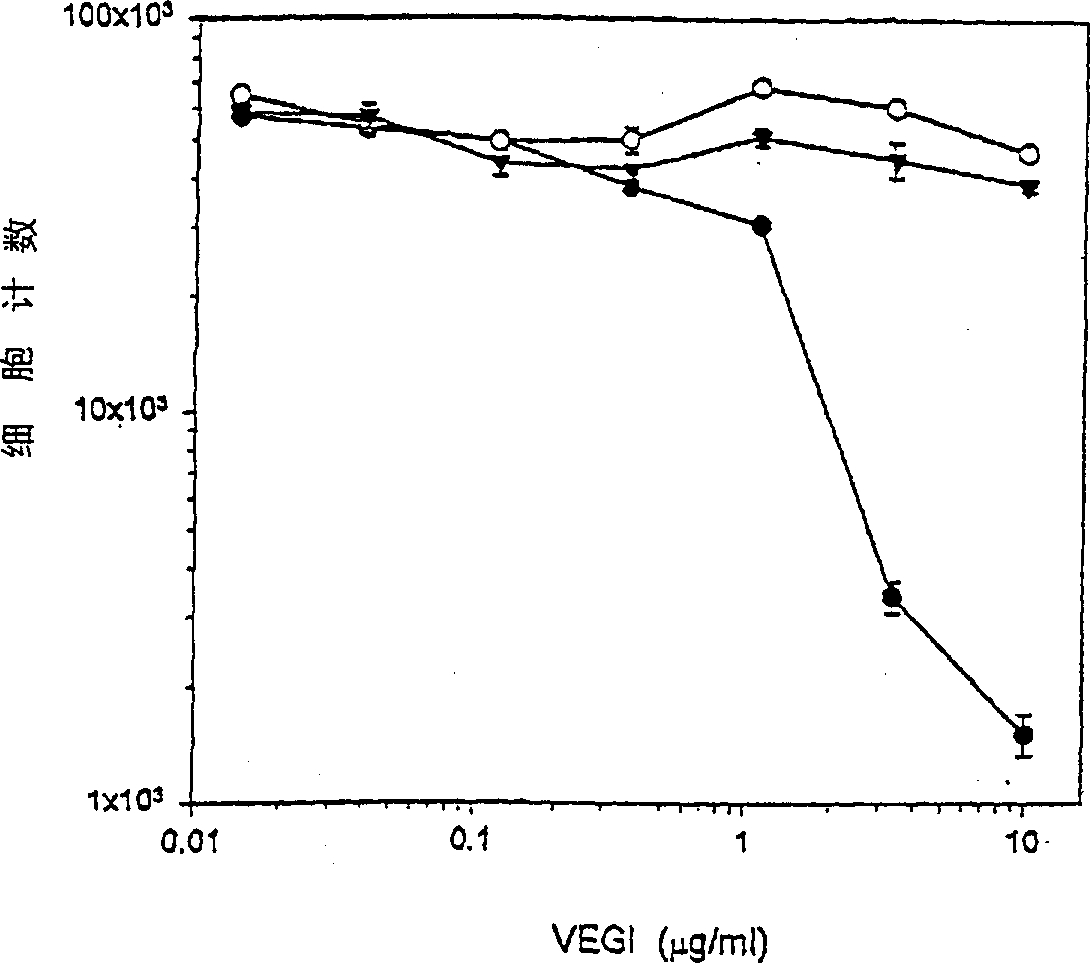VEGI, an inhibitor of angiogenesis and tumor growth
An angiogenesis and preparation technology, applied in the fields shown in , can solve the problems of undisclosed angiogenesis inhibition and the like
- Summary
- Abstract
- Description
- Claims
- Application Information
AI Technical Summary
Problems solved by technology
Method used
Image
Examples
Embodiment approach
[0230] In another embodiment, the present invention relates to a method for detecting the presence or absence of VEGI polypeptide in a sample, so as to diagnose or prognose diseases related to angiogenesis, by using standard methods known in the art, on the surface (i.e. a solid support ) coated with antibodies specific to VEGI polypeptides, such as microtiter plates or membranes (such as nitrocellulose membranes), and the coated surface with serum, tissue or other biological or other biological or Chemical sample exposure allows for diagnostic analysis. The presence or absence of the resulting complex formed between a VEGI polypeptide and an antibody specific for it in a sample can be detected by any general method known in the art, such as fluorescent antibody spectroscopy or colorimetry. The detection method can be used, for example, in diagnosing or prognosing cancer.
[0231] In another embodiment, the present invention relates to a diagnostic kit comprising an antibody ...
Embodiment 1
[0315] Example 1 Bacterial expression and purification of VEGI polypeptide
[0316]An expression vector was constructed, which contained a polynucleotide encoding 38 amino acids of the N-terminus of the putative full-length VEGI-α polypeptide deleted. The DNA sequence encoding the N-terminally deleted VEGI-alpha polynucleotide was amplified with PCR oligonucleotide primers specific for the VEGI-alpha coding sequence. Additional nucleotides that create restriction sites to facilitate cloning are added to the 3' and 5' sequences, respectively. The 5' oligonucleotide primer has the sequence 5'-GCGCCA TGG CTC TGCACT GGG AAC AT-3' (SEQ ID NO: 3) containing an Nco I restriction site followed by 18 nucleotides of the coding sequence. The 3' primer has the sequence 5'-CGC AAG CTTCTA TAG TAA GAA GGC TCC-3' (SEQ ID NO: 4) containing a HindIII restriction site followed by 18 complementary to the last 15 nucleotides of the coding sequence and a stop codon sub-nucleotides. After digesti...
Embodiment 2
[0319] Embodiment 2: clone and express VEGI polypeptide with baculovirus expression system
[0320] The DNA sequence encoding the full-length VEGI-α polypeptide, ATCC NO75927, was amplified using PCR oligonucleotide primers corresponding to the 5' and 3' sequences of the gene. The 5' primer sequence is 5'-GCG CGG ATC CAC CAT GAG ACG CTT TTT AAGCAA AGT C-3' (SEQ ID NO: 15) and contains a Barn HI restriction enzyme site (in bold) followed by VEGI-α 24 nucleotides of the coding sequence (the translation initiation codon "ATG is underlined). The 3' primer sequence is 5'-CGC GTC TAG ACT ATA GTAAGA AGG CTC CAA AGA AGG-3' (SEQ ID NO: 16), and Contain the cleavage site of restriction endonuclease XbaI and be complementary to 22 nucleotides of the 3' untranslated sequence of VEGI-α coding sequence. Use commercially available kit ("Geneclean," BIO 101 Inc., La Jolla, Ca.) The amplified sequence was separated from a 1% agarose gel. This fragment was then digested with endonucleases BamH...
PUM
 Login to View More
Login to View More Abstract
Description
Claims
Application Information
 Login to View More
Login to View More - R&D
- Intellectual Property
- Life Sciences
- Materials
- Tech Scout
- Unparalleled Data Quality
- Higher Quality Content
- 60% Fewer Hallucinations
Browse by: Latest US Patents, China's latest patents, Technical Efficacy Thesaurus, Application Domain, Technology Topic, Popular Technical Reports.
© 2025 PatSnap. All rights reserved.Legal|Privacy policy|Modern Slavery Act Transparency Statement|Sitemap|About US| Contact US: help@patsnap.com



